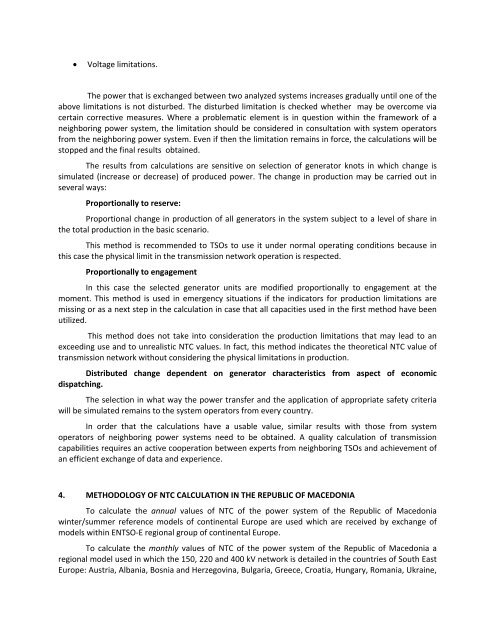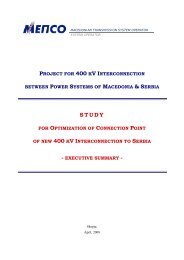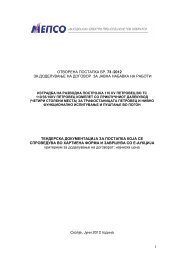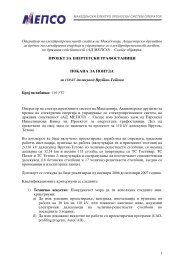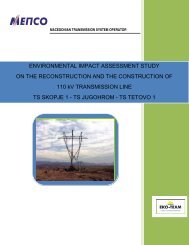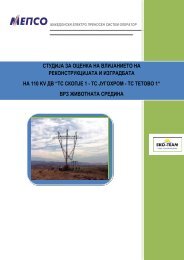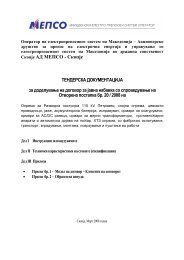Rules for Allocation of Cross-border Transmission Capacities
Rules for Allocation of Cross-border Transmission Capacities
Rules for Allocation of Cross-border Transmission Capacities
You also want an ePaper? Increase the reach of your titles
YUMPU automatically turns print PDFs into web optimized ePapers that Google loves.
• Voltage limitations.<br />
The power that is exchanged between two analyzed systems increases gradually until one <strong>of</strong> the<br />
above limitations is not disturbed. The disturbed limitation is checked whether may be overcome via<br />
certain corrective measures. Where a problematic element is in question within the framework <strong>of</strong> a<br />
neighboring power system, the limitation should be considered in consultation with system operators<br />
from the neighboring power system. Even if then the limitation remains in <strong>for</strong>ce, the calculations will be<br />
stopped and the final results obtained.<br />
The results from calculations are sensitive on selection <strong>of</strong> generator knots in which change is<br />
simulated (increase or decrease) <strong>of</strong> produced power. The change in production may be carried out in<br />
several ways:<br />
Proportionally to reserve:<br />
Proportional change in production <strong>of</strong> all generators in the system subject to a level <strong>of</strong> share in<br />
the total production in the basic scenario.<br />
This method is recommended to TSOs to use it under normal operating conditions because in<br />
this case the physical limit in the transmission network operation is respected.<br />
Proportionally to engagement<br />
In this case the selected generator units are modified proportionally to engagement at the<br />
moment. This method is used in emergency situations if the indicators <strong>for</strong> production limitations are<br />
missing or as a next step in the calculation in case that all capacities used in the first method have been<br />
utilized.<br />
This method does not take into consideration the production limitations that may lead to an<br />
exceeding use and to unrealistic NTC values. In fact, this method indicates the theoretical NTC value <strong>of</strong><br />
transmission network without considering the physical limitations in production.<br />
Distributed change dependent on generator characteristics from aspect <strong>of</strong> economic<br />
dispatching.<br />
The selection in what way the power transfer and the application <strong>of</strong> appropriate safety criteria<br />
will be simulated remains to the system operators from every country.<br />
In order that the calculations have a usable value, similar results with those from system<br />
operators <strong>of</strong> neighboring power systems need to be obtained. A quality calculation <strong>of</strong> transmission<br />
capabilities requires an active cooperation between experts from neighboring TSOs and achievement <strong>of</strong><br />
an efficient exchange <strong>of</strong> data and experience.<br />
4. METHODOLOGY OF NTC CALCULATION IN THE REPUBLIC OF MACEDONIA<br />
To calculate the annual values <strong>of</strong> NTC <strong>of</strong> the power system <strong>of</strong> the Republic <strong>of</strong> Macedonia<br />
winter/summer reference models <strong>of</strong> continental Europe are used which are received by exchange <strong>of</strong><br />
models within ENTSO‐E regional group <strong>of</strong> continental Europe.<br />
To calculate the monthly values <strong>of</strong> NTC <strong>of</strong> the power system <strong>of</strong> the Republic <strong>of</strong> Macedonia a<br />
regional model used in which the 150, 220 and 400 kV network is detailed in the countries <strong>of</strong> South East<br />
Europe: Austria, Albania, Bosnia and Herzegovina, Bulgaria, Greece, Croatia, Hungary, Romania, Ukraine,


